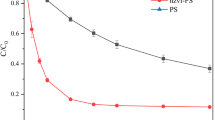Abstract
Sewage containing antibiotics is harmful to the water environment. Here, a newly prepared iron manganese binary oxide (FMBO) activated persulfate (PDS) has excellent performance for the degradation of sulfapyridine (SPY) in an aqueous environment. The effects of initial pH, SPY, PDS concentration and FMBO dosage on the degradation ability of SPY were investigated. When the pH of FMBO/PDS was 4.0 and the initial concentration of PDS was 2.0 mmol/L, the degradation ratio of SPY could reach 94.4%. In the system of removing organic pollutants by transition metal activated PDS, SO −•4 and •OH radicals are generally generated, and •OH radical plays a major role. Through the identification of SPY intermediate products by LC/MS, the degradation mechanism was explored. The degradation pathway showed that the strong oxidation of FMBO and the activity of PDS promoted the production of hydroxyl radical and contributed to the degradation and transformation of antibiotics. This study shows that FMBO/PDS has high degradation efficiency in the degradation of SPY.
Similar content being viewed by others

Data Availability
All data generated or analyzed during this study are included in this published article.
References
J. Deng, S. F. Shao and K. J. Zhang, Chem. Eng. J., 308, 505 (2017).
J. Deng, H. Wu and S. J. Wang, Environ. Technol., 40, 1585 (2019).
S. Cai, Y. Liu and J. Chen, Environ. Chem. Lett., 18, 1693 (2020).
R. Bhuvaneswari, V. Nagarajan and R. Chandiramouli, Phys. Lett. A, 394, 127198 (2021).
F. H. Geng, T. T. Jia and S. W. Zhang, Water Purificat. Technol., 37, 89 (2018).
H. Chen and K. C. Carroll, Environ. Pollut., 215, 96 (2016).
J. Cao, W.X. Zhang and D. G. Brown, Environ. Eng. Sci., 25, 221 (2008).
A. Outsiou, Z. Frontistis and R. S. Ribeiro, Water Res., 124, 97 (2017).
Y. Chen, P. Deng and P. Xie, Chemosphere, 168, 1628 (2017).
Y. Feng, D.L. Wu and Y. Deng, Environ. Sci. Technol., 50, 3119 (2016).
W. J. Sang, Z. X. Li and M. J. Huang, J. Environ. Sci., 39 (2019).
K. Wu, X. Y. Si and J. Jiang, Environ. Sci. Pollut. R., 26, 14350 (2019).
X. J. Liu, X. W. Zhang and Z. Z. Wu, Mod. Chem. Ind., 38, 92 (2018).
W. Zheng, X. Yang and J.F. Zhang, Environ. Sci. Technol., 30, 41 (2007).
B. Nikravesh, A. Shomalnasab and A. Nayyer, J. Environ. Chem. Eng., 8, 104244 (2020).
C. Liang, C. F. Huang and Y. J. Chen, Water Res., 42, 4091 (2008).
X. R. Xu and X. Z. Li, Sep. Purif. Technol., 72, 105 (2010).
F. Ghanbari, Q. Wang and A. Hassani, Chemosphere, 279, 130610 (2021).
S. Y. Oh and D. S. Shin, J. Chem. Technol. Biot., 88, 145 (2013).
S. H. Zhang, D. J. Tan and Q. Y. Chen, J. Donghua Univ. Nat. Sci., 39, 814 (2013).
G. P. Anipsitakis and D. D. Dionysiou, Environ. Sci. Technol., 38, 3705 (2004).
G. D. Fang, D. D. Dionysiou and S. R. Al-Abed, Appl. Catal. B-Environ., 129, 325 (2013).
T. K. Sesegma, T. D. Elvira and V. D. Darima, Appl. Clay Sci., 146, 92 (2017).
Acknowledgements
This work was supported by the Platform construction project in Wuhu [grant number Kjcxpt202004] and the 2021 University-level scientific research project [grant number wzyzrzd202108].
Author information
Authors and Affiliations
Corresponding author
Ethics declarations
Conflict of interest The authors declare no competing interests.
Rights and permissions
About this article
Cite this article
Wu, K., Zhang, Z., Hua, F. et al. Degradation of sulphapyridine by Fe-Mn binary oxide-mediated radical reactions. Korean J. Chem. Eng. 39, 2685–2690 (2022). https://doi.org/10.1007/s11814-022-1139-7
Received:
Revised:
Accepted:
Published:
Issue Date:
DOI: https://doi.org/10.1007/s11814-022-1139-7



